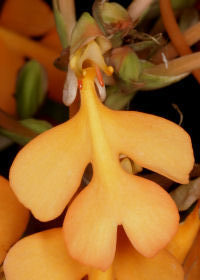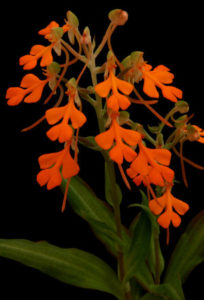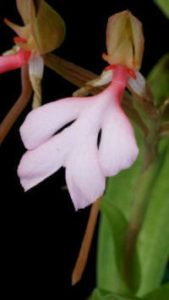The following article was written for the Orchid Species Bulletin published by the Orchid Species Society, which is based in Brisbane, Queensland in December 2010.
Bear in mind that any cultivation notes refer to the subtropical conditions of Southern Queensland, Australia.

Habenaria rhodocheila Hance is a showy terrestrial that was described by Henry Hance in Annales des Sciences Naturelles in 1856, based upon a plant collected by Sampson in Canton (Kwangtung), China. The specific epithet comes from the Greek rhodo (rose, rosy-red) and cheilos (lip) for the rosy coloured lip of the type.
Plants of Hab. rhodocheila consist of bulbous or cylindrical fleshy roots with an upright stem that is 10-30 cm long. There are 2-6 stalked leaves at the base of the stem with 3-4 smaller bract-like leaves borne further along the stem. The basal linear-lanceolate leaves are 6-12 cm long and 8-30 mm broad. They are green with a finer network of darker green veins. Its inflorescence is densely 2-10 (-15) flowered.

The showy flowers of Hab. rhodocheila have greenish sepals and petals and the prominent 4-lobed, spurred lip varies from scarlet or brick-red to rarely orange, pink or yellow. Its dorsal sepal and petals form a green hood above the column. The slender petals are slightly spathulate and one-veined. Two colour forms were shown at the November 2010 meeting. One of these had a rose-pink lip and the lip of the other was orange.

The rarer Hab. carnea has olive green leaves with pale, almost white, spots. It is distinguished by the entirely pale pink or sometimes white flowers that have oblique petals which are broadly ovate with several veins. Its lip is finely papillose on the upper surface and finely papillose hairy along the margin. Widely distributed, Hab. rhodocheila is found from Thailand, Cambodia, Laos, Vietnam, southern China and south to Peninsular Malaysia, and Mindanao in the Philippines.
After flowering, the leaves die down, leaving the fleshy tubers underground which should be kept dry. A winter minimum of 12-15oC is recommended. After new green shoots appear the tubers should be repotted and grown under 80% shade. Any well-drained, moisture-retentive potting medium is suitable. Care with watering must be given at first, until growth is well under way, after which the plants should not be allowed to dry out. Too much water during the early stages of new growth can lead to damping off.
